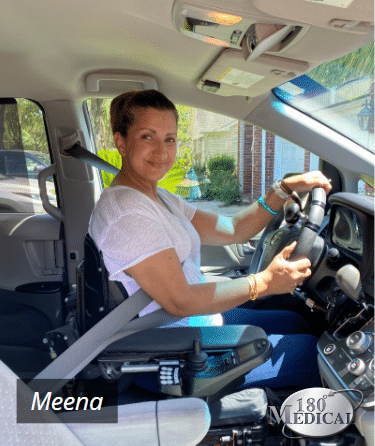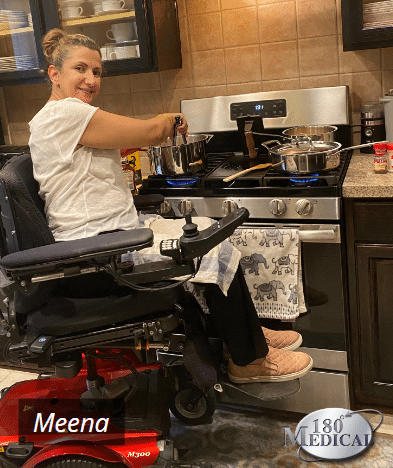
After sustaining a spinal cord injury, many people live with paralysis and lack of sensation in some parts of their bodies. While the level of injury will dictate each individual’s mobility and sensory issues, it’s important to maintain health through exercise after a spinal cord injury.
During the rehabilitation after a spinal cord injury, physical therapists typically recommend exercises that are appropriate to each individual’s level of injury. They may also let you know that it’s important to move your joints and muscles each day to keep your body limber. Plus, exercise may help reduce the risk of muscle atrophy or joint contractures from poor positioning and lack of movement.
Of course, it’s human nature to get complacent about keeping up with an exercise plan when you’re busy or if things are going well. However, have you ever thought about the potential drawbacks if you discontinue your at-home exercise plan? How would that affect your daily tasks?
Driving with a Spinal Cord Injury
While able-bodied people might think just sitting and driving a car wouldn’t really require the need for exercise, it’s actually quite the opposite. If we neglect exercise, it may affect our ability to drive, which is one of our sources of independence after a spinal cord injury. Also, it may also negatively impact your ability to transfer from your wheelchair into the car and use your hand controls while driving.
Staying strong and limber through regular exercise after your spinal cord injury can play a huge role in how safely you can maneuver your vehicle.

Housework and Cooking with a Spinal Cord Injury
Lifting, carrying, and reaching are all involved in the daily tasks of taking care of your own home, depending on your level of spinal cord injury. Keeping your core, arm, chest, and back muscles strong (depending on your level of injury) can be essential to these tasks.
Just a simple movement like lifting a pot full of water from the stove or taking something out of the refrigerator requires your muscles. Even more importantly, our safety can be compromised by muscle weakness or lack of range of motion when doing tasks like removing food from a hot oven.
Also, you don’t want to tire too quickly in the middle of a chore like cooking or cleaning the house. This could lead to dropping and breaking fragile items like glass, which could lead to a mess or even potential injuries.

Transferring to and from a Wheelchair
If you ever moved from your wheelchair to your bed, you know that it takes some arm strength to help you do this smoothly without the chance of falling. Many will also use their core muscles to roll onto their bed if their injury level affects their arm strength and motion.
However, if you have upper arm movement, strengthening the triceps will be an added bonus. Getting a pair of small dumbbells and working this area for even as little as 10 minutes a day should help strengthen you to safely scoot and lift yourself from your wheelchair to your bed, couch, toilet, shower chair, bathtub, or your car.

Breathing After a Spinal Cord Injury
It may seem odd for me to mention breathing. However, spinal cord injuries can actually impact this essential function of our respiratory system. This may be due to the muscles in and around the lungs being impacted by the injury or becoming weak later on. People with spinal cord injuries are also at a higher risk of respiratory dysfunction and pneumonia.
This is why it’s so important for those of us living with spinal cord injuries to exercise our bodies and our lungs. Luckily, you can perform some really basic exercises every day to help prevent your risk of pneumonia and other respiratory illnesses. Exercises that require you to stretch and reach are helpful. If you have kids, play catch with them. It’s a great way to get some movement into your day while also bonding with your family. If you cannot move your arms or have limited mobility above the waist or chest, even adaptive yoga and meditation may help.
Add breathing exercises to your daily regimen too. The Shepherd Center, a non-profit rehabilitation hospital in Atlanta, GA, shares some helpful breathing exercises to perform.
If you have difficulty breathing, it may be a good idea to speak to your doctor to get referred to a respiratory therapist.
Exercise After a Spinal Cord Injury Can Help Your Overall Quality of Life
Exercise and keeping our bodies as healthy as possible is important to all of us, whether we are disabled or able-bodied. In addition to checking out my other blogs regarding living with a spinal cord injury, it’s a good idea to talk to your physical therapist or doctor about easy at-home exercises you can perform. Also, YouTube offers a wealth of helpful exercise videos for people with spinal cord injuries.
I know firsthand that those of us living with spinal cord injuries have busy lives to lead too. Just like able-bodied people, we often spend our days at school, at work, caregiving, and more. However, that can lead to putting ourselves and our own health on the backburner. I hope you can see now how essential exercise is to our overall quality of life after a spinal cord injury. Invest in yourself with exercise.